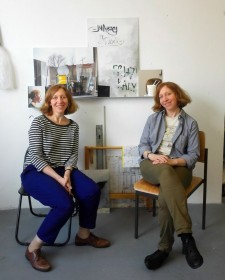
Daniel Wiesenfeld at work. The freshly baked glass plates cool off in the oven, 2015
© Jewish Museum Berlin, photo: Anna Golus
The last few weeks, while people everywhere were sizzling in the summer sun, Daniel Wiesenfeld was ‘baking’ a hundred new works of art for our art vending machine. What good luck, meanwhile, that the machine is nearly sold out!
Daniel is presenting the Jewish Museum Berlin with what is already the third series of works for the vending machine, all three of which are incomparable. In April we received a hundred oil paintings with self-portraits of the artist bearing a variety of poignant grimaces, along with a hundred charcoal drawings featuring a number of different motifs. For this new series, Daniel decided on a technique that’s new not only for him but for the vending machine as well: stained glass.
I visited Daniel a few days ago in Berlin’s Tempelhof neighborhood. → continue reading
It always goes by so quickly: it feels as if the third round just started, of the art vending machine in the Jewish Museum Berlin’s permanent exhibition. But in fact it’s almost finished and sold out – 2,600 items since April! That’s certainly enough reason to pop by to visit Howard Katz and ask him some questions, especially considering that he was the first of the now 22 artists we’ve featured to use music…

Howard Katz © Yoann Trillu
Dagmar Ganßloser: Howard, you work as an artist in many different genres. You’re a dancer, performer, and choreographer, but you’re also an active visual artist, and on top of that a singer-songwriter. Right now the art vending machine has your “Mix Tape” as well as “4 short films”. How did you choose those?
Howard Katz: It was clear to me from the start that I wanted to present my music in the art vending machine. The 17 songs on “Mix Tape” came into being over the last twenty years plus and – the same as “4 short films” – they’re mainly about experiences I’ve had since I’ve lived in Berlin, so since the mid-1990s. The production was uncomplicated and I made the selection intuitively, from the heart. I made the four videos for my songs completely on my own, with my telephone – it was an opportunity to try out something new. → continue reading
A Conversation with the Artists Maria und Natalia Petschatnikov
The end of May, as the first palpable rays of sun shone in Berlin, offered the perfect occasion for an outing to Berlin’s Kreuzberg neighborhood. There the artists Maria and Natalia Petschatnikov showed me their atelier and told me about “Sparrows” and “4 Euros,” the two objects they made for the Jewish Museum Berlin’s art vending machine. They also talked about their current projects and responded with good humor to all of my questions above and beyond the subject of art.

Maria (left) and Natalia Petschatnikov in front of part of their project “Berlin & Berlin”, 2015
© and photo by Michaela Roßberg
Michaela Roßberg: You work together and you’re twins – identical twins. What is it like to work so closely? How do you develop ideas and work on projects? And does one or the other of you start with an image of the finished work in mind?
Maria: We do a lot through dialogue. It isn’t that one of us has an idea and, once a project is finished, could say: “That was my idea.” Our work emerges from a joint process. For instance, we walk through the city and see interesting things that get us thinking. We talk about them, and together, start forming ideas. → continue reading


